Minnesota, the ‘Land of 10,000 Lakes’, melds northern forests with expansive prairies and wetlands. From the dense forests to the shimmering lakes, Minnesota’s diverse landscapes are home to a rich tapestry of bird species.
Among them, the state boasts an array of striking red birds that capture the imagination of birdwatchers and nature lovers alike.
Dive into this guide as we unveil 12 of Minnesota’s most vibrant red avian wonders. Whether you’re a seasoned birder or just starting out, our accompanying FREE photo guide will be a valuable companion on your birdwatching journey.
Red Birds Found In Minnesota
Minnesota stands as a crossroads of ecological regions, making it a melting pot of diverse habitats. From the coniferous forests of the north to the grasslands in the south, the state’s varied landscapes offer a unique confluence of environments suitable for a wide range of avian species.
Moreover, its abundant water bodies, including rivers and lakes, provide critical breeding and migratory stopover points for numerous birds.
Northern Cardinal


| Feature | Measurement |
|---|---|
| Scientific Name | Cardinalis cardinalis |
| Length | 8.3 – 9.1 in |
| Wingspan | 9.8 – 12.2 in |
| Weight | 1.19 – 2.29 oz |
The Northern Cardinal is an iconic North American bird, easily recognized by its vibrant color and melodious song.
Appearance: Male Northern Cardinals are a brilliant scarlet red, while females display a more subdued reddish olive. Both sexes have a distinctive black ‘mask’ on their face around the bill and a pointed crest on their head. The bird’s beak is robust, cone-shaped, and bright orange in color.
Diet: Northern Cardinals are primarily granivorous, with a diet largely consisting of seeds and grains. They also eat fruits and insects. These birds typically feed off the ground and are frequent visitors to bird feeders.
Reproduction: Northern Cardinals are monogamous, and a pair will breed together for life. The female typically builds a well-hidden nest in a dense thicket or shrub. She lays 2-5 eggs per clutch, which she incubates for around two weeks.
Scarlet Tanager


| Feature | Measurement |
|---|---|
| Scientific Name | Piranga olivacea |
| Length | 6.3 to 7.5 in |
| Wingspan | 9.8 to 11.8 in |
| Weight | 23.5 to 38 g |
The Scarlet Tanager is a strikingly colorful bird known for its brilliant plumage and distinctive song.
Appearance: Male Scarlet Tanagers are notable for their vibrant scarlet bodies contrasted with black wings and tail, making them one of the most intensely colored birds. Females and juveniles, on the other hand, have a subdued olive-yellow body color with darker wings and tail.
Diet: The diet of the Scarlet Tanager is largely made up of insects, including beetles, cicadas, aphids, and others. They are adept flycatchers, seizing insects in mid-air or picking them off foliage. They also consume fruits and berries, especially during migration and in their winter habitats.
Reproduction: The female Scarlet Tanager builds a cup-shaped nest using twigs, rootlets, and grass, typically well-hidden in the dense foliage of trees. She lays 3 to 5 eggs and incubates them for about two weeks.
Red-headed Woodpecker

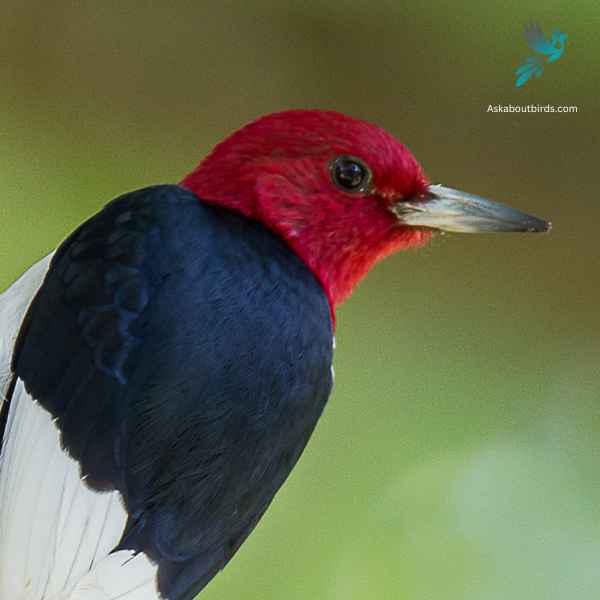
| Feature | Measurement |
|---|---|
| Scientific Name | Melanerpes erythrocephalus |
| Length | 7.5–9.1 in |
| Wingspan | 16.5 in |
| Weight | 2.0–3.2 oz |
The Red-headed Woodpecker is a striking forest bird with a bold tri-colored pattern.
Appearance: This woodpecker features a completely red head and neck, contrasting starkly with its white underparts and black wings. Its wings also have large white patches which are conspicuous in flight.
Diet: Red-headed Woodpeckers have a varied diet including insects, seeds, fruits, berries, and occasionally even the eggs of other birds. They’re also known to store food by wedging it into crevices in bark.
Reproduction: These woodpeckers nest in cavities which they excavate in dead wood or dead parts of live trees. These cavities can be found anywhere from 2 to 80 feet off the ground.
Summer Tanager


| Feature | Measurement |
|---|---|
| Scientific Name | Piranga rubra |
| Length | 6.7 in |
| Wingspan | 28 to 30 cm |
| Weight | 29 g |
The Summer Tanager is a medium-sized songbird admired for its radiant plumage and melodious song.
Appearance: Male Summer Tanagers are an impressive bright red, while females and juveniles present a softer, yellow-orange color. Both genders have a large, slightly hooked bill and relatively short tail.
Diet: Summer Tanagers primarily feed on insects, including bees and wasps, which they catch in flight or pick off vegetation. They are also known to eat fruits and berries, making them helpful in controlling pest populations and seed dispersal.
Reproduction: The female Summer Tanager builds a loose, shallow cup-shaped nest out of twigs and grass, usually hidden in the foliage of trees. The female typically lays 3-5 eggs, which she will incubate for about two weeks.
Rose-breasted Grosbeak
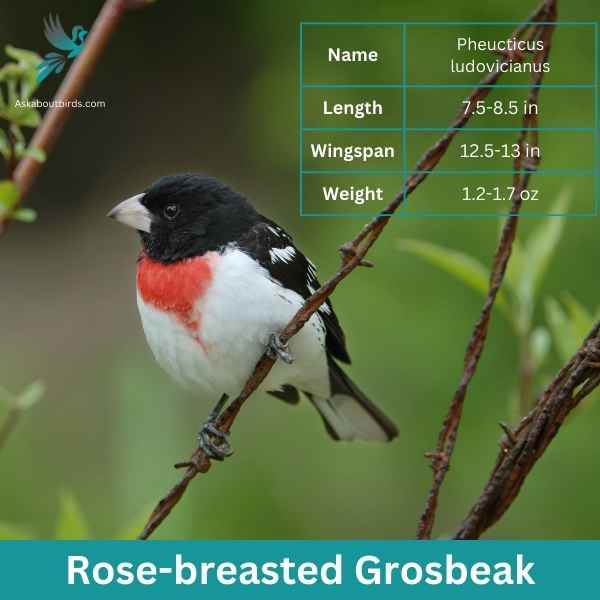

| Feature | Measurement |
|---|---|
| Scientific Name | Pheucticus ludovicianus |
| Length | 7.5-8.5 in |
| Wingspan | 12.5-13 in |
| Weight | 1.2-1.7 oz |
The Rose-breasted Grosbeak is a songbird of medium size, widely recognized for its vibrant coloration and melodious song.
Appearance: Male Rose-breasted Grosbeaks boast a striking contrast with black and white plumage accompanied by a radiant rose-colored patch on the chest and under the wings. In contrast, females exhibit streaked brown and white plumage, resembling large sparrows but with a thick bill.
Diet: The diet of the Rose-breasted Grosbeak consists of a mixture of seeds, insects, and fruits. During summer, they primarily feed on insects, while seeds and fruits become more prevalent in their diet during the colder months.
Reproduction: These birds build cup-shaped nests typically situated in trees or large shrubs. Both the male and female partake in incubation duties, ensuring the eggs’ safety and warmth. After hatching, the chicks are primarily fed insects.
Red-Winged Blackbird
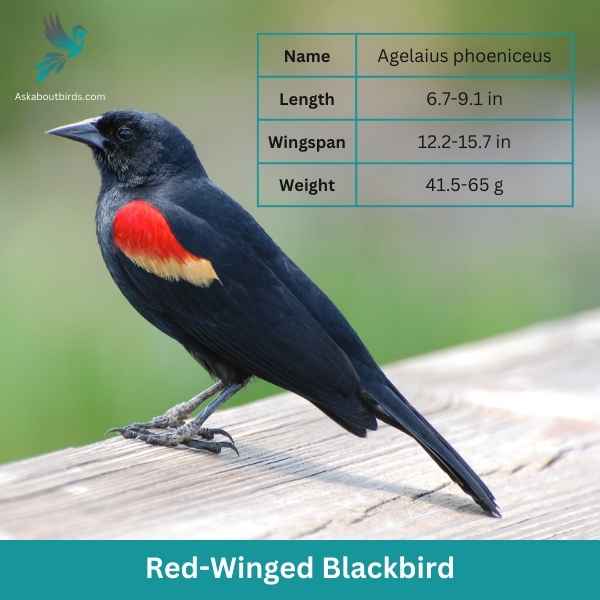
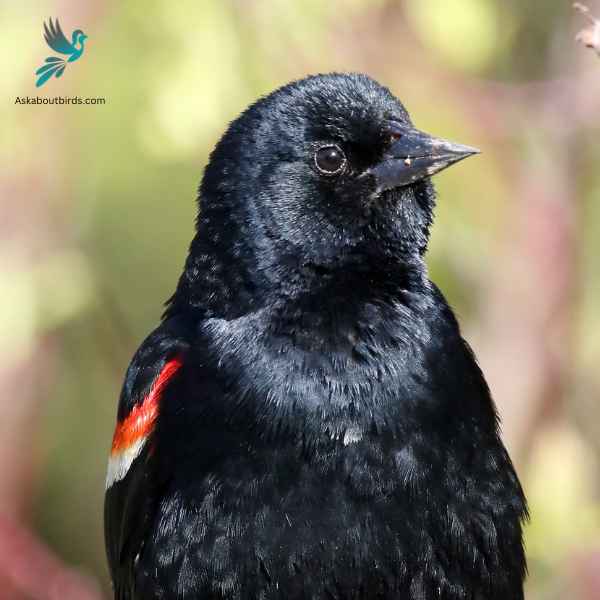
| Feature | Measurement |
|---|---|
| Scientific Name | Agelaius phoeniceus |
| Length | 6.7-9.1 in |
| Wingspan | 12.2-15.7 in |
| Weight | 41.5-65 g |
The Red-Winged Blackbird is a familiar sight across North America, especially in wetlands and open areas. Known for its striking coloration and distinct call, it is often seen perched on cattails or utility lines.
Appearance: Male Red-Winged Blackbirds are glossy black with bright red-and-yellow shoulder patches, while females are streaky brown, resembling a large sparrow. The males’ red patches become more prominent when they’re displaying or agitated.
Diet: Red-Winged Blackbirds primarily feed on seeds and insects. Their diet includes grains, sunflower seeds, and corn, but they also eat beetles, caterpillars, and other small invertebrates, especially in the breeding season.
Reproduction: Red-Winged Blackbirds nest in marshes, along watercourses, and in wet fields. The female constructs a cup-shaped nest using grass and sedge, attaching it to plants above water. She typically lays a clutch of 3 to 4 blue-green eggs, which she incubates for about 11-12 days. Males, being polygynous, often have multiple mates during a single breeding season.
Purple Finch


| Feature | Measurement |
|---|---|
| Scientific Name | Haemorhous purpureus |
| Length | 4.7–6.3 in |
| Wingspan | 4.7–6.3 in |
| Weight | 0.6–1.1 oz |
The Purple Finch is a vibrant songbird often mistaken for its close relative, the House Finch, but it exhibits a different hue and patterns.
Appearance: Males are raspberry red on the head, throat, and breast, with streaky brown backs and wings. The intensity of the red can vary among individuals. Females are brown and streaked all over but might show a slight blush on the face. They lack the strong facial patterns seen in female House Finches.
Diet: Purple Finches primarily consume seeds, with a preference for sunflower seeds, dandelion seeds, and buds. They also eat insects and berries, especially during the breeding season.
Reproduction: These finches often nest in conifers or mixed woodlands. The nest, typically located on a horizontal branch, is made from twigs and grass, then lined with feathers.
House Finch


| Feature | Measurement |
|---|---|
| Scientific Name | Haemorhous mexicanus |
| Length | 5–6 in |
| Wingspan | 8–10 in |
| Weight | 0.6–0.9 oz |
The House Finch is a small songbird widely distributed across North America and is commonly found in urban and suburban areas.
Appearance: Males of this species are brightly colored with crimson faces and throats, which can extend to the chest and back, while their flanks have streaks. The female is streaked brown and lacks the red coloring. Both have a square-tipped tail and a distinctively long, flat-topped bill.
Diet: House Finches primarily eat seeds, grains, and berries. They have a particular fondness for sunflower seeds and can be commonly seen at bird feeders. Occasionally, they will also consume insects, especially during the breeding season.
Reproduction: House Finches are cavity-nesters and might choose ledges, vents, ledges, and other urban settings. They might also utilize trees or shrubs. Their nests can be made of a wide array of materials, from feathers to twigs.
Pine Grosbeak

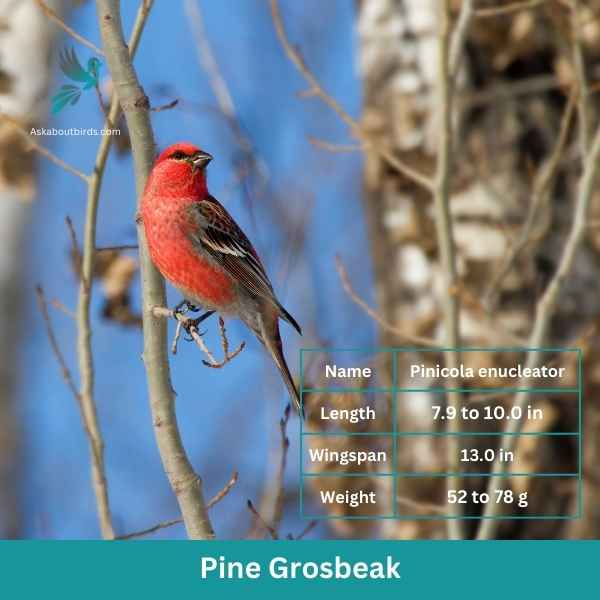
| Feature | Measurement |
|---|---|
| Scientific Name | Pinicola enucleator |
| Length | 7.9 to 10.0 in |
| Wingspan | 13.0 in |
| Weight | 52 to 78 g |
The Pine Grosbeak is a striking bird native to the northern regions of North America, often found in coniferous forests. Both males and females have a plump and robust body with a large beak adapted for eating seeds. The male Pine Grosbeak displays a vibrant reddish-pink plumage, while the female has a more subdued grayish-brown coloration.
These birds are typically seen in small flocks, foraging for food in trees and on the ground. They have a preference for seeds, particularly those from various conifer species. The Pine Grosbeak uses its strong bill to crack open the cones of tall trees and extract the seeds, but they also consume berries and small fruits when available.
Common Redpoll

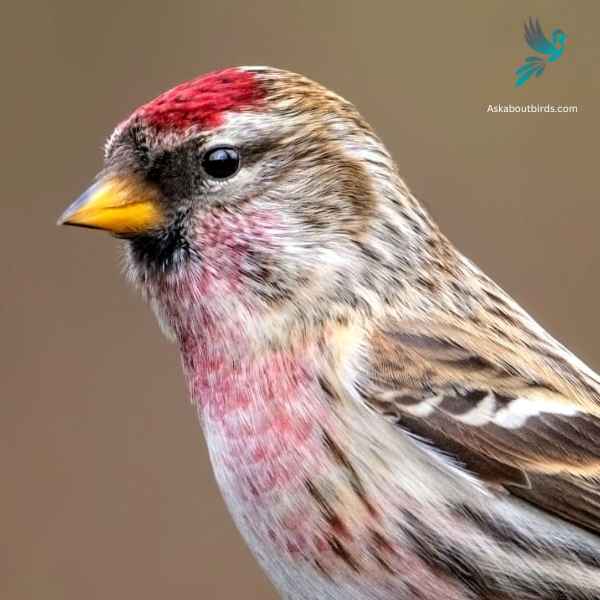
| Feature | Measurement |
|---|---|
| Scientific Name | Acanthis flammea |
| Length | 5.0-5.5 in |
| Wingspan | 7.5-8.5 in |
| Weight | 0.4-0.9 oz |
The Common Redpoll is a small songbird that is easily identifiable by its rosy-red forehead, black chin, and often fluttering flight pattern.
Appearance: Common Redpolls exhibit a distinctive rosy-red forehead patch and black chin. The males typically have a more extensive pink wash on their chest and face than females. The rest of their body is primarily streaked brown and white, with two white wing bars and a notched tail.
Diet: The diet of the Common Redpoll predominantly consists of seeds, particularly from birches and alders. They have a specialized throat pouch where they can temporarily store seeds, allowing them to consume them later in a more sheltered location.
Reproduction: Common Redpolls nest in shrubs or on the ground, using grasses, twigs, and feathers for construction. The female is responsible for the majority of the incubation and typically lays a clutch of 4 to 6 eggs. After the eggs hatch, both parents take part in feeding the young.
American Redstart


| Feature | Measurement |
|---|---|
| Scientific Name | Setophaga ruticilla |
| Length | 4.3 to 5.5 in |
| Wingspan | 6.3 to 9.1 in |
| Weight | 8.6 g |
The American Redstart is a lively warbler known for its vivid colors and active hunting style, often seen flitting about, fanning its tail to startle and catch insects.
Appearance: Adult male American Redstarts boast striking black plumage with bright orange patches on the sides, wings, and tail. Females and immature males have grayish-olive upperparts with yellow patches in the same areas where the males display orange.
Diet: American Redstarts are primarily insectivores. They actively forage for flying insects, as well as caterpillars and spiders, often using their colorful tails to startle prey and make them easier to catch.
Reproduction: The female American Redstart builds a cup-shaped nest in the fork of a tree branch. Typically, she lays a clutch of 3 to 5 eggs. The female takes on the primary responsibility of incubating the eggs, while both parents participate in feeding the fledglings after they hatch.
Red Crossbill

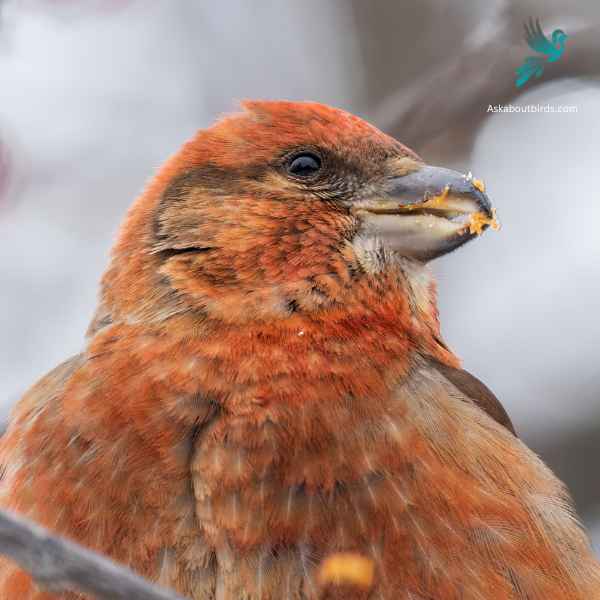
| Feature | Measurement |
|---|---|
| Scientific Name | Loxia curvirostra |
| Length | 5.5–7.5 in |
| Wingspan | 9.8–10.6 in |
| Weight | 0.9–1.4 oz |
The Red Crossbill is a distinctive finch known for its unusual bill, which has evolved to extract seeds from conifer cones.
Appearance: Males are typically bright red or orange, while females are greenish-yellow or olive. Both genders have the characteristic crossed bill, which they use to expertly extract seeds from tightly closed conifer cones.
Diet: Red Crossbills primarily feed on the seeds of coniferous trees, such as spruce, pine, and fir. Their specialized bills allow them to efficiently pry apart conifer cone scales to access the seeds.
Reproduction: Red Crossbills are somewhat nomadic and don’t adhere to a strict breeding schedule. Instead, they breed whenever and wherever food is abundant. Their nests are usually built on horizontal branches of conifer trees.
Where to Spot Minnesota’s Red Birds
Minnesota’s diverse landscapes are a haven for bird enthusiasts. Among its picturesque terrains, here are the top spots that stand out for their bird-watching potential, especially for those passionate about red birds:
- Agassiz National Wildlife Refuge: Located in northwest Minnesota, this refuge is home to over 290 species of birds. Its mix of wetlands, grasslands, and forests offers an ideal setting to spot red birds like the Scarlet Tanager and the Northern Cardinal.
- Tamarac National Wildlife Refuge: Nestled in the heart of the transition zone where tallgrass prairies, hardwood forests, and conifer forests converge. This refuge is a hotspot for observing a plethora of bird species, including the Red-headed Woodpecker.
- Sax-Zim Bog: A world-renowned birding destination, this vast bog in northern Minnesota is a magnet for many bird species, especially during winter. It’s one of the few places where you might catch a glimpse of the elusive Evening Grosbeak.
- Minnesota Valley National Wildlife Refuge: Spanning along the Minnesota River, its floodplain habitat is a prime spot for bird watching. Apart from a myriad of waterfowl, one can also spot vibrant red birds such as the Red-winged Blackbird.
- Itasca State Park: As the headwaters of the Mississippi River, this park offers more than just scenic beauty. Dense forests and over 100 lakes within the park’s boundaries make it a premier location for observing a variety of birds, including the Ruby-throated Hummingbird.
| State’s Red Birds | Top Spots For Red Birds |
|---|---|
| North Dakota’s Red Birds | 1. Lostwood National Wildlife Refuge 2. Chase Lake National Wildlife Refuge 3. Turtle Mountain State Forest |
| South Dakota’s Red Birds | 1. Custer State Park 2. Bear Butte State Park 3. Sand Lake National Wildlife Refuge |
| Iowa’s Red Birds | 1. Neal Smith National Wildlife Refuge 2. Ledges State Park 3. Effigy Mounds National Monument |
| Wisconsin’s Red Birds | 1. Horicon Marsh 2. Chequamegon-Nicolet National Forest 3. Apostle Islands National Lakeshore |
FAQs on Red Bird Species Found in Minnesota
Why are pine grosbeaks attracted to backyard feeders during the winter months?
Pine grosbeaks, sporting bright red plumage in adult males and pale brown in females, are remarkable bird species that flock to backyard feeders, especially during winter. Their preference for bird feeders filled with black oil sunflower seeds, coupled with their appetite for conifer seeds found in pine trees, makes them frequent winter birds at many feeders.
How can one differentiate between the painted bunting and other bird species in South America?
The painted bunting stands out as a unique spectacle among bird species in South America. This tiny bird boasts an ensemble of yellow-green, bright red plumage, and dark gray wings. Moreover, while other bird species might have consistent colors, the painted bunting’s medley of hues, especially the bright red feathers, makes bird identification straightforward for enthusiasts.
What characteristics distinguish the male house finch from female birds?
The male house finch is easily recognizable by its bright red feathers on the throat and chest, contrasting starkly with the more common house finch females, which exhibit brown plumage. Additionally, while male house finches may also showcase a red throat patch and white eyebrow stripe, female birds typically possess a pale bill and lack the vibrant red coloration.
How do palm warblers differ from blue birds in terms of feeding habits?
Palm warblers, often seen flitting around forest edges, are known for catching insects as their primary diet. Their yellow feathers and tail feathers are often a blur as they chase their prey. On the other hand, blue birds, despite their commonality, differ significantly. They might frequent bird feeders filled with black oil sunflower seeds, showcasing a distinct feeding preference compared to the insect-loving warblers.




